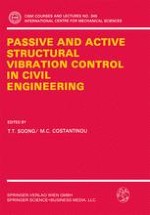1994 | OriginalPaper | Buchkapitel
Summary and Concluding Remarks
verfasst von : T. T. Soong
Erschienen in: Passive and Active Structural Vibration Control in Civil Engineering
Verlag: Springer Vienna
Enthalten in: Professional Book Archive
Aktivieren Sie unsere intelligente Suche, um passende Fachinhalte oder Patente zu finden.
Wählen Sie Textabschnitte aus um mit Künstlicher Intelligenz passenden Patente zu finden. powered by
Markieren Sie Textabschnitte, um KI-gestützt weitere passende Inhalte zu finden. powered by
As we have seen, remarkable progress has been made in the area of base isolation, passive energy dissipation, and active control. Recent advances in seismic isolation hardware and the benefit offered by this technology have been responsible for a rapid increase in the number of base-isolated buildings in the world, both new construction and retrofit.The basic role of passive energy dissipation devices when incorporated into a structure is to consume a portion of the input energy, thereby reducing energy dissipation demand on primary structural members and minimizing possible structural damage. Over the last twenty years, serious efforts have been undertaken to develop the concept of supplemental damping into a workable technology and it has now reached the stage where a number of these devices have been installed in structures throughout the world.In comparison with base isolation and passive energy dissipation, active control is a relatively new area of research and technology development. However, we again see a rapid development in this area, to the point that active systems have been installed in several structures in Japan.
